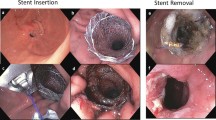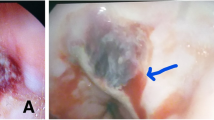Abstract
Purpose
Banded Roux-en-Y gastric bypass (RYGB) was a common bariatric procedure in the 2000s, and the ring slippage is one of its late adverse events. Both plastic and metallic stents have been reported as adjunct methods to induce erosion and facilitate endoscopic removal of the ring.
Objective
To compare the safety and effectiveness of self-expanding metallic stents (SEMS) and plastic stents (SEPS) to treat ring slippage.
Materials and Methods
We conducted a retrospective longitudinal study analyzing consecutive patients with ring dysfunction treated with stents plus endoscopic removal.
Results
Ninety patients were enrolled (36 SEMS vs. 54 SEPS). The mean age was 48.56 ± 13.07 and 45.6 ± 12.1 in the SEMS and SEPS groups, respectively. All patients had band slippage, but 24 from SEMS group and 23 from SEPS group had further complications. There were more complications in metallic stent concerning mean absolute number of therapy-related adverse events (1.33 ± 0.48 vs. 1.72 ± 0.5, p > 0.05) and time until erosion (14.9 ± 1.6 vs. 13.8 ± 1.4 days, p > 0.05). Female sex and age > 41 years old correlated with longer time to band erosion and higher incidence of adverse events in SEMS patients. In SEPS group, only female sex was a risk factor for adverse events.
Conclusion
Both procedures were efficient at inducing band erosion with similar safety profiles. Older and female patients are at a higher risk of treatment-related adverse events, especially those receiving SEMS.
Graphical abstract





Similar content being viewed by others
References
WHO-World Health Organization. Available in: https://www.who.int/topics/obesity/en/ - 62k. Accessed 25 Sept 2019.
Hales CM, Carroll MD, et al. Prevalence of obesity among adults and youth: United States, 2015–2016. NCHS data brief, no 288. Hyattsville, MD: National Center for Health Statistics. 2017.
IBGE- Instituto Brasileiro de Geografia e Estatística. Disponível em: < http://www.ibge.gov.br>. Acessado em julho de 2019.
Marins Campos J, Moon RC, Magalhães Neto GE, et al. Endoscopic treatment of food intolerance after a banded gastric bypass: inducing band erosion for removal using a plastic stent. Endoscopy. 2016;48(6):516–20. https://doi.org/10.1055/s-0042-103418.
Almby K, Edholm D. Anastomotic strictures after Roux-en-Y gastric bypass: a cohort study from the Scandinavian Obesity Surgery Registry. Obes Surg. 2019;29(1):172–7. https://doi.org/10.1007/s11695-018-3500-9.
Docimo S Jr, Svestka M. Endoscopic evaluation and treatment of postoperative bariatric surgery complications. Surg Innov. 2017;24(6):616–24. https://doi.org/10.1177/1553350617736651.
Lemmens L, Karcz WK, Bukhari W, et al. Banded gastric bypass – four years follow up in a prospective multicenter analysis. BMC Surg. 2014;14:88.
Buchwald H, Buchwald JN, McGlennon TW. Systemic review and meta-analysis of medium-term outcomes after banded Roux-en-Y gastric bypass. Obes Surg. 2014;24:1536–51.
Stubbs RS, O’brien I, Jurikova L. What ring size should be used in association with vertical gastric bypass? Obes Surg. 2006;16:1298–303.
Heneghan HM, Annaberdyev S, Eldar S, et al. Banded Roux-en-Y gastric bypass for the treatment of morbid obesity. Surg Obes Relat Dis. 2014;10:210–6.
Fobi M, Lee H, Igwe D, et al. Band erosion: incidence, etiology, management and outcome after banded vertical gastric bypass. Obes Surg. 2001;11:699–707.
Valezi AC, Mali Junior J, de Menezes MA, et al. Weight loss outcome after silastic ring Roux-en-Y gastric bypass: 8 years of follow-up. Obes Surg. 2010;20:1491–5.
Elias AA, Garrido-Junior AB, Berti LV, et al. Roux-en-Y gastric bypass with silicone ring for the obesity treatment: study of the complications related to the ring. Arq Bras Cir Dig. 2011;24:290–5.
Ferraz A, Campos J, Dib V, et al. Food intolerance after banded gastric bypass without stenosis: aggressive endoscopic dilation avoids reoperation. Obes Surg. 2013;23:959–64.
Campos JM, Evangelista LF, Ferraz AA, et al. Treatment of ring slippage after gastric bypass: long-term results after endoscopic dilation with an achalasia balloon (with videos). Gastrointest Endosc. 2010;72:44–9.
Blero D, Eisendrath P, Vandermeeren A, et al. Endoscopic removal of dysfunctioning bands or rings after restrictive bariatric procedures. Gastrointest Endosc. 2010;71:468–74.
Wilson T, Miller N, Brown N, et al. Stent induced gastric wall erosion and endoscopic retrieval of nonadjustable gastric band: a new technique. Surg Endosc. 2013;27:1617–21.
Hookey LC, Mehdi A, Moine LEO, et al. Removal of a gastroplasty ring. Gastrointest Endosc. 2005;61:594.
Elm EV, Altman DG, Egger M, et al. The Strengthening the Reporting of Observational Studies in Epidemiology (STROBE) statement: Guidelines for Reporting Observational Studies. PLoS Med. 2007;4:296. https://doi.org/10.1371/journal.pmed.0040296.
Dugan J, Bajwa K, Singhal S. Endoscopic removal of gastric band by use of a stent-induced erosion technique. Gastrointest Endosc. 2016;83(3):654–5. https://doi.org/10.1016/j.gie.2015.09.019.
Moon RC, Teixeira AF, Bezerra L, et al. Management of bariatric complications using endoscopic stents: a multi-center study. Obes Surg. 2018;28(12):4034–8. https://doi.org/10.1007/s11695-018-3467-6.
Hassan TM, Ontiveros E, Davis D, et al. Endoscopic removal of noneroded nonadjustable gastric bands using induced mucosal erosion with a stent, and review of the literature. Surg Innov. 2019;26(2):162–7. https://doi.org/10.1177/1553350618820377.
Author information
Authors and Affiliations
Corresponding author
Ethics declarations
Conflict of Interest
The authors declare no competing interests.
Additional information
Publisher's Note
Springer Nature remains neutral with regard to jurisdictional claims in published maps and institutional affiliations.
Key Points
• Food intolerance can be a long-term complication in cases of banded gastric bypass.
• Endoscopic treatment using stents is safe and effective in cases of ring slippage or food intolerance.
• The use of plastic or metallic self-expanding prostheses was safe and effective to induce band erosion with subsequent endoscopic removal.
• Although stenosis occurred more frequently in metallic stent, regular endoscopic management resolved all cases.
Rights and permissions
About this article
Cite this article
de Quadros, L.G., Faria, D.C.G., Neto, M.G. et al. Banded RYGB Ring Slippage Endoscopic Removal with Self-expandable Stents: a Comparative Study Between Metallic and Plastic One. OBES SURG 32, 115–122 (2022). https://doi.org/10.1007/s11695-021-05742-x
Received:
Revised:
Accepted:
Published:
Issue Date:
DOI: https://doi.org/10.1007/s11695-021-05742-x




